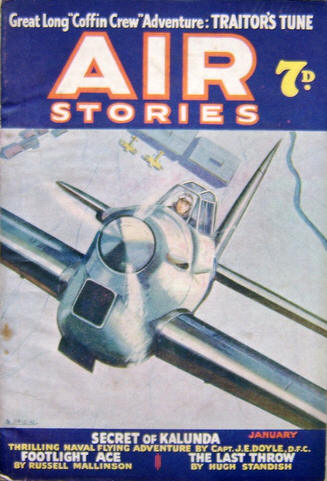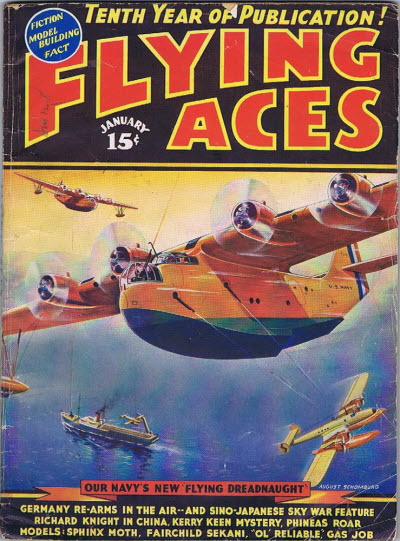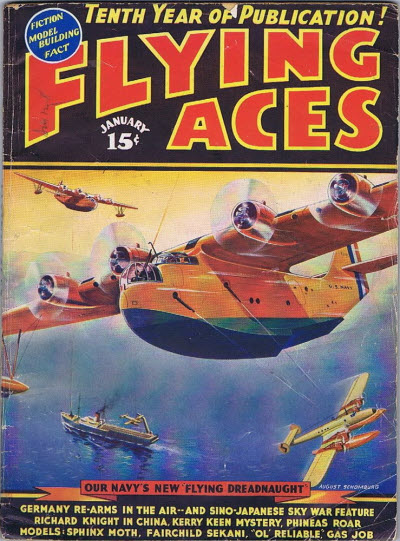“Traitor’s Tune” by Arch Whitehouse
THIS month we’re celebrating  the Christmas Season with The Coffin Crew! Yes, Arch Whitehouse’s hell-raising Handley Page bomber crew! Piloting the bus is the mad Englishman, Lieutenant Graham Townsend, with the equally mad Canadian Lieutenant Phil Armitage serving as reserve pilot and bombing officer with Private Andy McGregor, still wearing his Black Watch kilts, rounding out the front end crew in the forward gun turret. And don’t forget the silent fighting Irishman Sergeant Michael Ryan, usually dragging on his short clay pipe while working over the toggle board dropping the bombs with Alfred Tate and crazy Australian Andy Marks or Horsey Horlick manning the rear gun turret.
the Christmas Season with The Coffin Crew! Yes, Arch Whitehouse’s hell-raising Handley Page bomber crew! Piloting the bus is the mad Englishman, Lieutenant Graham Townsend, with the equally mad Canadian Lieutenant Phil Armitage serving as reserve pilot and bombing officer with Private Andy McGregor, still wearing his Black Watch kilts, rounding out the front end crew in the forward gun turret. And don’t forget the silent fighting Irishman Sergeant Michael Ryan, usually dragging on his short clay pipe while working over the toggle board dropping the bombs with Alfred Tate and crazy Australian Andy Marks or Horsey Horlick manning the rear gun turret.
Hawker, Ball, Rhys-Davids, McCudden, Mannock—and now Mackenzie—lost. The news of Mackenzie’s disastrous loss spred quickly—youthful Major Mackenzie, the colorful British ace of Scottish ancestry, had captured the imagination of every soldier in the British trenches. They dubbed him “The Mad Major” because of his amazingly daring exploits in “ground strafing” German trenches. Lost.
Enter the Coffin Crew! Somehow The Coffin Crew turns their disastrous landing behind enemy lines to their benefit when Andy McGregor’s curiosity is peaked as the Crew try to head back across the lines unmolested.
From the pages of the January 1938 number of the British Air Stories, it’s Arch Whitehouse’s final Coffin Crew tale—”Traitor’s Tune!”
It was a Strange Clue that First Linked a Lonely Graveyard behind the Enemy’s Lines with the Mysterious Disappearance of Britain’s Greatest Air Fighters, and Led that Crazy Band of Night Bombers, the Coffin Crew, upon the Most Desperate Adventure of their Madcap Fighting Career!
“Flight Team Flight!” by Joe Archibald
“HAW-W-W-W-W!† That sound can only mean one thing—that Bachelor of Artifice, Knight of Calamity and an alumnus of Doctor Merlin’s Camelot College for Conjurors is back to vex not only the Germans, but the Americans—the Ninth Pursuit Squadron in particular—as well. Yes it’s the marvel from Boonetown, Iowa himself—Lieutenant Phineas Pinkham!
That sound can only mean one thing—that Bachelor of Artifice, Knight of Calamity and an alumnus of Doctor Merlin’s Camelot College for Conjurors is back to vex not only the Germans, but the Americans—the Ninth Pursuit Squadron in particular—as well. Yes it’s the marvel from Boonetown, Iowa himself—Lieutenant Phineas Pinkham!
Life on the drome of the Ninth Pursuit Squadron savored of raccoon coats, chrysanthemums, and ticket scalpers. The pigskin fever had hit the squadron and football was the ruling passion when the Spads were not upstairs. Twelve miles away, a limey squadron, irked by certain remarks from an ex-footballer from Boonetown, Iowa, to the effect that the British rugby was a sissy’s pastime, had challenged the Ninth to a game, American style. For three weeks the Limey pilots had been practicing under the tutelage of a Yankee top-kick who claimed he had once scored a touchdown for Weakfish Normal against Purdue. From the pages of the January 1938 issue of Flying Aces, Phineas lets go with a pass, a punt and a prank as the Ninth must “Flight Team Flight!” by Joe Archibald.
“Crashity—spiff! Crashity—spiff! Kill the bums who eat roas’ biff!†So sang Sergeant Casey’s grease monkey cheering section on that sunny day when Major Garrity led his hardy Ninth Pursuit eleven against Captain Hardleigh-Bryte and his lambasting Limeys. But meanwhile the Vons had put over a spinner that reversed the field so you could see into the basements of laundries in China. And if it hadn’t been for Pinkham’s timely lateral, the Allies might have ended up horizontal.
“Famous Sky Fighters, January 1938″ by Terry Gilkison
STARTING in the October 1933 issue of Sky Fighters and running almost 5 years, Terry Gilkison’s “Famous Sky Fighters†was a staple of the magazine. Each month Gilkison would illustrate in a two page spread different Aces that rose to fame during the Great War.
Although Gilkison was probably better known for his syndicated newspaper work, he also provided black and white story interior illustrations for pulp magazines. His work appeared in Clues, Thrilling Adventures, Texas Rangers, Thrilling Mystery, Thrilling Western, and Popular Western. Gilkison provided similar features in a few other Thrilling Publications—there was “Famous Soldiers of Fortune” and later “Adventure Thrills” in Thrilling Adventures, Famous Crimes” in Thrilling Detective, and the fully illustrated air adventure stories of Buck Barton “The Flying Devil” in The Lone Eagle! He signed most of this work with only his initials “T.G.” to maintain a low profile and preserve his reputation as a syndicated newspaper cartoon artist.
The January 1938 installment, from the pages of Sky Fighters, features Lt. Paul Pavelka, Captain Georges Madon, General Italo Balboas and famous American adventurer Walter Wellman!


Next time in “Famous Sky Fighters”, Terry Gilkison features Col. William A. Bishop, Lt. Elliott Cowden, Captaincies. J.A. Bellinger, Lt. Kiffen Rockwell and the Zeppelin L59! Don’t miss it!
Richard Knight vs “Aces of Death” by Donald E. Keyhoe
THE prolific Donald E. Keyhoe  had a story in a majority of the issue of Flying Aces from his first in January 1930 until he returned to the Navy in 1942. Starting in August 1931, they were stories featuring the weird World War I stories of Philip Strange. But in November 1936, he began alternating these with sometime equally weird present day tales of espionage Ace Richard Knight—code name Agent Q. After an accident in the Great War, Knight developed the uncanny ability to see in the dark. Aided by his skirt-chasing partner Larry Doyle, Knights adventures ranged from your basic between the wars espionage to lost valley civilizations and dinosaurs.
had a story in a majority of the issue of Flying Aces from his first in January 1930 until he returned to the Navy in 1942. Starting in August 1931, they were stories featuring the weird World War I stories of Philip Strange. But in November 1936, he began alternating these with sometime equally weird present day tales of espionage Ace Richard Knight—code name Agent Q. After an accident in the Great War, Knight developed the uncanny ability to see in the dark. Aided by his skirt-chasing partner Larry Doyle, Knights adventures ranged from your basic between the wars espionage to lost valley civilizations and dinosaurs.
“Aces of Death” from the pages of the January 1938 issue of Flying Aces is Keyhoe’s eight story with the intrepid Q-Agent and his pal Larry Doyle.
What infernal power had loosed those gun-bristling Grummans upon stricken China? And who were the merciless white devils who flew them like madmen and who fought like fiends? This sinister riddle called for the unfailing skill of Richard Knight. But even that ace agent was balked. For the winged killer from whom he sought to wrest its answer leaped into the flaming inferno of his own fallen plane—gave vent in his death throes to a defiant scream of triumph.
 the Christmas Season with The Coffin Crew! Yes, Arch Whitehouse’s hell-raising Handley Page bomber crew! Piloting the bus is the mad Englishman, Lieutenant Graham Townsend, with the equally mad Canadian Lieutenant Phil Armitage serving as reserve pilot and bombing officer with Private Andy McGregor, still wearing his Black Watch kilts, rounding out the front end crew in the forward gun turret. And don’t forget the silent fighting Irishman Sergeant Michael Ryan, usually dragging on his short clay pipe while working over the toggle board dropping the bombs with Alfred Tate and crazy Australian Andy Marks or Horsey Horlick manning the rear gun turret.
the Christmas Season with The Coffin Crew! Yes, Arch Whitehouse’s hell-raising Handley Page bomber crew! Piloting the bus is the mad Englishman, Lieutenant Graham Townsend, with the equally mad Canadian Lieutenant Phil Armitage serving as reserve pilot and bombing officer with Private Andy McGregor, still wearing his Black Watch kilts, rounding out the front end crew in the forward gun turret. And don’t forget the silent fighting Irishman Sergeant Michael Ryan, usually dragging on his short clay pipe while working over the toggle board dropping the bombs with Alfred Tate and crazy Australian Andy Marks or Horsey Horlick manning the rear gun turret.




 That sound can only mean one thing—that Bachelor of Artifice, Knight of Calamity and an alumnus of Doctor Merlin’s Camelot College for Conjurors is back to vex not only the Germans, but the Americans—the Ninth Pursuit Squadron in particular—as well. Yes it’s the marvel from Boonetown, Iowa himself—Lieutenant Phineas Pinkham!
That sound can only mean one thing—that Bachelor of Artifice, Knight of Calamity and an alumnus of Doctor Merlin’s Camelot College for Conjurors is back to vex not only the Germans, but the Americans—the Ninth Pursuit Squadron in particular—as well. Yes it’s the marvel from Boonetown, Iowa himself—Lieutenant Phineas Pinkham! 

 had a story in a majority of the issue of Flying Aces from his first in January 1930 until he returned to the Navy in 1942. Starting in August 1931, they were stories featuring the weird World War I stories of Philip Strange. But in November 1936, he began alternating these with sometime equally weird present day tales of espionage Ace Richard Knight—code name Agent Q. After an accident in the Great War, Knight developed the uncanny ability to see in the dark. Aided by his skirt-chasing partner Larry Doyle, Knights adventures ranged from your basic between the wars espionage to lost valley civilizations and dinosaurs.
had a story in a majority of the issue of Flying Aces from his first in January 1930 until he returned to the Navy in 1942. Starting in August 1931, they were stories featuring the weird World War I stories of Philip Strange. But in November 1936, he began alternating these with sometime equally weird present day tales of espionage Ace Richard Knight—code name Agent Q. After an accident in the Great War, Knight developed the uncanny ability to see in the dark. Aided by his skirt-chasing partner Larry Doyle, Knights adventures ranged from your basic between the wars espionage to lost valley civilizations and dinosaurs.